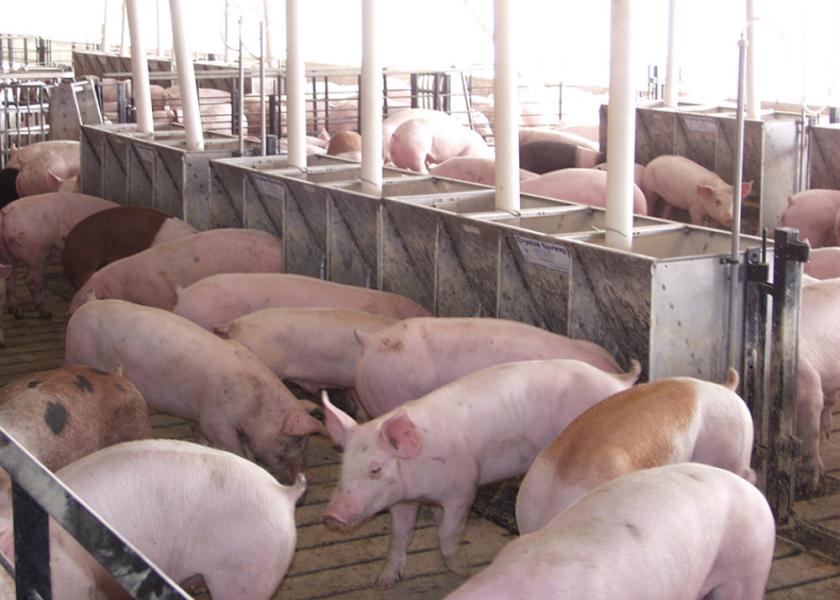Impact of Higher Corn Prices on Swine Finishing Feed Cost

Corn price futures for the December 2019 contract increased from $3.79 per bushel for the week ending May 10 to $4.55 for the week ending June 28. Even though corn futures prices weakened after the release of the June crop acreage report, using the iFarm price distribution tool (here) there was still a 19 percent chance on July 9 that corn futures will be above $5.00 per bushel. Moreover, due to continued questions related to U.S. corn acreage in 2019, there is tremendous uncertainty regarding corn prices during the rest of the year. To address this uncertainty, this article examines the impact of potentially higher corn prices on feed cost indices for a swine finishing enterprise.
The swine finishing enterprise assumes the finishing of an early-weaned pig. The ration for this enterprise consists of corn, soybean meal, dry distillers’ grain, and supplements. Corn prices represent averages for Indiana as reported by USDA-NASS. Soybean meal and distillers’ grain prices are obtained from Feed Outlook, published monthly by USDA-ERS. Information from Agricultural Prices, a monthly USDA-NASS publication, was used to compute supplement prices. Future prices for corn and soybean meal are used to project feed indices through 2019. Feed cost indices are reported on a closeout month rather than a placement month basis.
Corn and Soybean Meal Prices
Figures 1 and 2 report monthly corn and soybean meal prices from January 2000 to May 2019. A distinction is made for prices before and after 2007. The period starting in 2007 is often thought to be a new price regime. Corn price averaged $2.18 per bushel from 2000 to 2006, and $4.55 per bushel from 2007 to the current month. Soybean meal price averaged $187 per ton from 2000 to 2006, and $354 per ton from 2007 to the current month. Corn price was above $4.55 from February 2008 to September 2008, from November 2010 to September 2013, and from March 2014 to June 2014. Since July 2014, corn price has been below $4.55 per bushel. Soybean meal price was above $354 per ton from June 2008 to August 2008, from May 2009 to September 2009, in January and February 2011, from March 2012 to March 2015, in July and August 2015, and from May to July 2016. This illustrates how common it has been since 2007 for corn and soybean meal prices to spike. At the present time, corn has more upside potential than soybean meal prices.
Swine Finishing Enterprise
Figure 3 illustrates monthly swine finishing feed cost indices for the January 2000 to May 2019 period. The latest full year of indices, 2018, has an index of 100 so all indices outside of this year are expressed in relative terms. As with corn and soybean meal prices, a distinction is made between the before and after 2007 periods. The average index for the 2000 to 2006 period was 57 while the average index for the period beginning in 2007 was 112. The index for May 2019 was 100, so current feed costs are similar to those experienced in 2018.
Annual swine finishing feed cost indices are presented in figure 4. The projections for 2019 (red bar) used corn and soybean meal futures prices in early July. The projected feed cost indices for 2019 is 101. This indicates that with current price projections, feed costs in 2019 will be similar to those experienced in 2018. However, given the uncertainty regarding corn acreage, corn prices could potentially be higher than current projections. The impact of a potential spike in corn prices is discussed below.
Sensitivity Analysis for Swine Feed Cost
Feed costs are very sensitive to changes in corn and soybean meal prices. Regression analysis was used to examine the relationship between hog finishing costs, and corn and soybean meal prices. Results are as follows: each 0.10 increase in corn prices increases feed cost per cwt by $0.44, and each $10 increase in soybean meal prices increases feed cost per cwt. by $0.32. Feed cost per cwt. in May was $31.22. Using expected corn and soybean meal prices, feed cost per cwt. is expected to range from $31.25 to $32.25 in the third quarter and from $33.00 to $34.00 in the fourth quarter of 2019.
Table 1 presents feed cost per cwt. for corn prices ranging from $3.75 to $4.75 per bushel, and soybean meal prices ranging from $275 to $375 per ton. At the upper range of the prices illustrated in table 1, feed cost per cwt. would be approximately $37.00. Though not shown, a corn price of $5.00 per bushel and soybean meal prices of $325, $350, and $375 per ton would result in feed cost per cwt. ranging from $36.25 to $38.00.
Conclusions
This article provided projections of feed cost indices and feed cost per cwt. for a swine finishing enterprise. With current projections feed costs are expected to increase from $1 to $2 per cwt. in the third quarter and from $2 to $3 per cwt. in the fourth quarter. These increases in feed costs represent percentage changes of 2 to 9 percent. If corn prices spike to $5.00 per bushel, feed costs could increase 16 to 21 percent.
References
County Estimates, United States Department of Agriculture, https://www.nass.usda.gov/Statistics_by_State/Indiana/Publications/County_Estimates/index.php, accessed July 11, 2019
Agricultural Prices, United States Department of Agriculture, https://usda.library.cornell.edu/concern/publications/c821gj76b , accessed July 11, 2019












